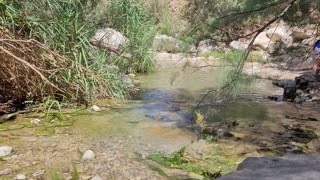Premium Only Content

How To Find Water In The Desert - Survival Tips
More Awesome Tech Insider Vids- https://www.youtube.com/channel/UCVLZmDKeT-mV4H3ToYXIFYg ...Deserts are areas that receive less than 10 inches (250 mm) of precipitation a year. They are hot and dry during the day and cold at night. The most important thing you need in a desert is water. The dry, hot temperatures will dehydrate you quickly, especially if you can't escape the sun and physical exertion.
Slow your rate of water loss. Exercise and sun exposure will speed up dehydration. Be smart about when you search for water. If possible, spend the hottest parts of the day in a shady location away from wind. Keep your skin covered to reduce water loss from sweat evaporation.
Follow wildlife. A group of animals almost always means water is nearby. Look for the following signs:
Listen for birdsong and watch the sky for circling birds.
If you encounter swarms of flies or mosquitoes, look nearby for water. Bees often fly in straight lines between water sources and the hive. Keep an eye out for animal tracks or trails, especially ones leading downhill.
Look for vegetation. Dense vegetation and most trees cannot survive without a steady water source.
If you are unfamiliar with local vegetation, aim for the greenest plants you can see. Deciduous and wide-leafed trees are typically a better sign than pine trees, as they tend to require more water.
If you can identify local plants, see below for species to look for.
In North America, look for cottonwoods, willows, sycamores, hackberry, salt cedar, arrow weed, and cattails.
In Australia, look for desert kurrajong, needle-bush, desert oak, or water bush. Keep an eye out for mallee eucalypts, or eucalypts that grow with multiple stems emerging outward from the same underground tuber.
Search up canyons and valleys. Your best bet is a canyon that stays shaded during the hot afternoon, upstream of the mouth. This means a north-facing canyon if you are in the Northern Hemisphere, or a south-facing canyon in the Southern Hemisphere. Find these with a topographical map if you have one, or eyeball the surrounding landscape.
Snow or rainfall is more likely to be retained in these cooler canyons, sometimes for months after a major rainstorm.
Find dry stream or river beds. Sometimes you can find water just under the surface. The best place to look is at a bend in the river, on the outside edge. The flowing water may have eroded this area down, creating a depression that catches the last dregs of water.
Find high ground if you see no other options. A hike to the high ground gives you the best vantage point to look for the features mentioned above.
When the sun is low in the sky, look for the glare of a reflection on the ground. This may be a body of water. If you are in an area used for cattle, you may see artificial water collection features at the base of gently sloping ground.
At the base of sloping rock features.
Near dense vegetation pockets, especially where bulges and cracks may indicate tree roots.
Anywhere the surface soil feels damp, or at least more clay-like than sandy.
Groundwater tends to be closest to the surface in the early morning, especially in areas with vegetation.
Look for moisture about a foot under the surface. Dig a narrow hole about 1 ft (30 cm) deep. If the ground is still dry, move on to a different spot. If you notice damp soil, move on to the next step.
Enlarge the hole. Expand the hole until it is about 1 ft (30 cm) in diameter. You may notice water seeping in from the sides, but finish digging even if you don't.
Wait for water to collect. Return to your hole after a few hours, or at the end of the day. If there was water in the soil, it should collect at the base of your hole.
Gather the water. If the water is difficult to reach, soak it up with a cloth and squeeze it into a container. Collect all the water right away, using makeshift containers if necessary. Water holes can empty fast in the desert.
Disinfect the water (recommended). Whenever possible, purify the water before drinking it. Boiling the water, using iodine tablets, or pouring it through an anti-microbial filter will remove almost all biological contaminants.
Collect dew. Look for dew drops on vegetation before dawn. To gather it, pass an absorbent cloth over the dew, then squeeze it into a container.
If you don't have absorbent cloth, form a clump of grass into a ball and use that instead.
Eat cactus fruit. These juicy fruits are safe to eat and contain enough moisture to supplement other sources. Collect the fruit carefully to avoid injury, then roast them in a fire for 30–60 seconds to burn off the spines and hairs.
You can eat prickly pear cactus pads as well. They are best when gathered young in the spring, then cooked. During other seasons they may be tough and hard to eat.
Music: From Scales To Feathers (Thirsty Lizard Mix) by Dhruva Aliman
Amazon- https://amzn.to/2Mgr7pg
https://music.apple.com/us/artist/dhruva-aliman/363563637
https://dhruvaaliman.bandcamp.com/album/the-wolf-and-the-river
http://www.dhruvaaliman.com/
Spotify - https://open.spotify.com/artist/5XiFCr9iBKE6Cupltgnlet
#prepper
#outdoors
#skills
-
 8:11
8:11
Seeker Land
5 days agoNASA Sends Astronauts To Moon In 2026 - Artemis II Mission
1301 -
 0:18
0:18
Dimau
3 years agoDesert and Water in deepest location in the world
25 -
 1:25:35
1:25:35
Roseanne Barr
14 hours ago $46.14 earnedKash Me Outside, Pedos | The Roseanne Barr Podcast #88
85K74 -
 1:21:55
1:21:55
Kim Iversen
10 hours agoMultiple States To BAN mRNA Vaccines | They Want to Make Protesting Illegal, Here's How
63.5K95 -
 7:34:25
7:34:25
Dr Disrespect
17 hours ago🔴LIVE - DR DISRESPECT - WARZONE - IMPOSSIBLE TRIPLE THREAT CHALLENGE
196K28 -
 1:02:45
1:02:45
Tundra Tactical
7 hours ago $19.79 earned🛑 KASH PATEL NEW ATF DIRECTOR??? Breaking News!!!! 🛑
57.4K8 -
 4:31:10
4:31:10
I_Came_With_Fire_Podcast
17 hours agoMy EURO Divorce | HOGG with a side of PAC | Foreign FUNDS Fudged
34K2 -
 37:44
37:44
Glenn Greenwald
14 hours agoGlenn On Tearing Down the Military Industrial Complex, Exposing Pro-Israel Indoctrination, and More | SYSTEM UPDATE #411
110K121 -
 4:04:20
4:04:20
Nerdrotic
13 hours ago $51.23 earnedAmazon Takes 007! Hollywood is Lost, Disney Cancels WHO? | Friday Night Tights 342 /w ItsAGundam
171K42 -
 43:27
43:27
Tucker Carlson
13 hours agoRay Dalio: America’s Hidden Civil War, and the Race to Beat China in Tech, Economics, and Academia
165K190